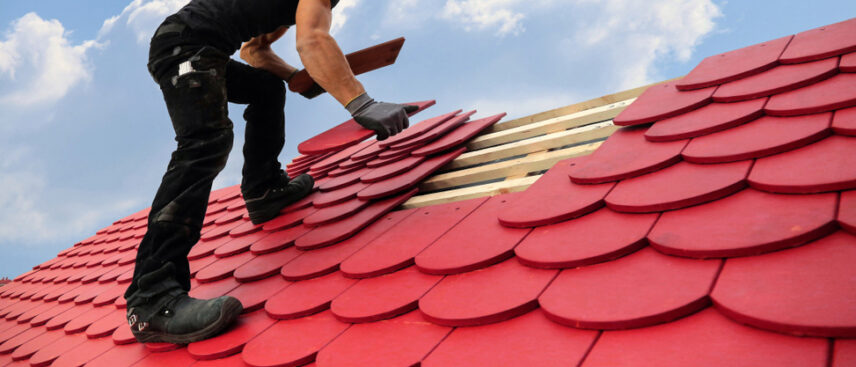If someone told you that updating one feature of your home could increase its resale value by more than 60%, would you do it? That’s the kind of potential a new roof holds.
Whether it’s time to replace your old roof or you’re building from the ground up, material selection matters. Just as you’d pore over countertops or paint colors, it’s important to choose your roofing materials thoughtfully and strategically.
As you begin your research, you’ll find that there are lots of options on the market. From asphalt, wood, and metal shingles to clay tiles, metal panels, and even “living” roofs, there’s a type to fit every homeowner’s style. The material you select should complement your home, fit comfortably within your budget, and be sturdy enough to withstand your local climate. Ideally, it will also be low-key and easy to maintain so you can keep it looking great for years to come.
Below, you’ll discover 12 of the most common roofing materials. You’ll also learn about the key features that set each one apart, average costs per square foot, and the pros and cons you need to know as you prepare for this important project.
Shingles
Several types of shingles are commonly used in home roofs. Wood and cedar shingles may be the classic look, however in recent decades many homeowners have opted for asphalt and synthetic shingles for their simple maintenance and minimalistic look.
Asphalt Shingles
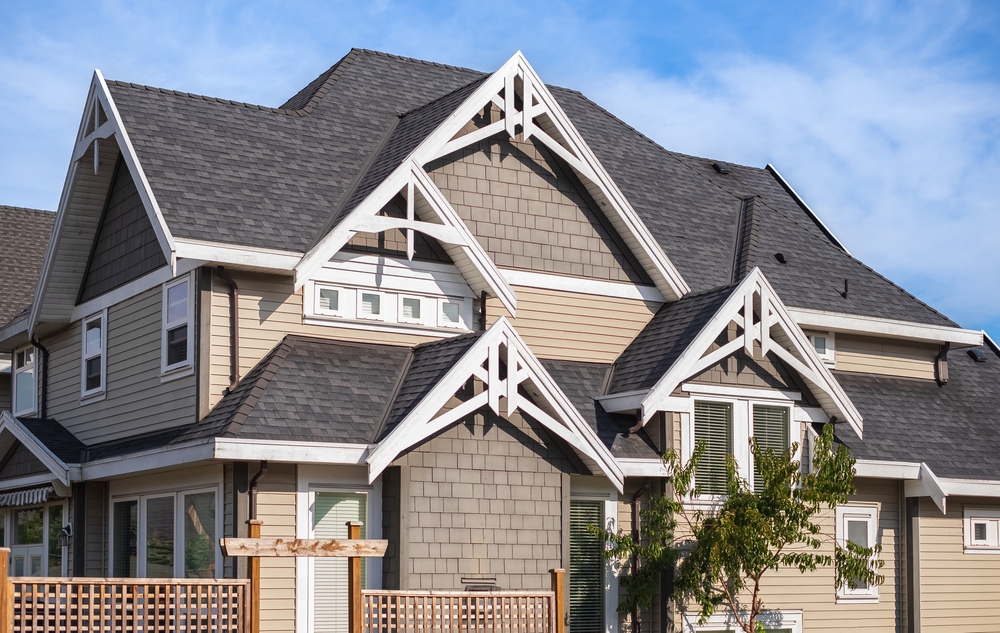
Asphalt shingles are the most commonly installed roofing shingle material in the U.S. Even as trends evolve, they’ve remained a mainstay in the construction industry because they’re affordable and easy to install.
Suitable for all roof types, they work best in moderate climates that don’t experience extreme temperatures. While they’ll hold up well against wind and rain, the shingles can fade under intense sunlight or crack from excessive hail or ice damming.
Each shingle consists of a fiberglass base layer, topped with a layer of asphalt mixed with mineral granules. You can also find organic versions made with a cellulose backing material. The asphalt component makes the roof waterproof, while the granules add UV protection and color.
Roofers install these shingle materials in an overlapping pattern, forming a tight seal that keeps water away from the underlayment. There is a range of styles available, including standard three-tab shingles, as well as dimensional or architectural models that come in a wider range of colors and patterns.
Roofers and homeowners alike appreciate that asphalt shingles are lightweight but extremely durable. Most come with a 20-to-30-year warranty, and they’re easy to source and replace if you need to repair a section.
Maintaining your asphalt shingles is as simple as keeping your gutters clean and free of debris. When they get clogged, water can back up under the shingles and cause damage. It’s also helpful to trim back any overhanging limbs that could rub against the granules or drop debris onto your roof.
Average cost of asphalt shingles: $4.25 to $8.25 or more per square foot
Pros:
- Inexpensive and easy to install
- Easy to replace
- Sturdy enough for most climates
- Adaptable to any home style
Cons:
- Can look generic
- Vulnerable to cracking and wind uplift
- Need to be installed in warm temperatures to avoid damage
- Don’t last as long as some other options
Learn more about asphalt shingles.
Wood Shingles and Shakes

If you love the look of a shingled roof but want something more unique than conventional asphalt, wood shingles and shakes might catch your eye. While these roofs are undeniably attractive, they can be more sensitive to adverse environmental conditions and might not last as long as some other roofing materials. They’re especially susceptible to damage from wildfires and excessive moisture, so keep this in mind if your area sees these types of weather events often.
Typically made from cedar or redwood, they can be installed on any kind of roof. Wood shingles are shaped like a slab and tend to have a thinner and more precise cut, while shakes are thicker and rougher in texture, created by splitting wood.
Most homeowners will hire professional roofers to apply a protective element to their roof every one to three years. This solution includes water and fire repellents as well as ingredients to eliminate fungi and algae growth. Regular power washing, debris removal, and gutter maintenance can also preserve its appearance.
When well-maintained, your wood shingle roof can last anywhere from 20 to 60 years. The specific timespan will largely depend on your climate, as roofs in damp conditions will normally last only 20 to 30 years.
Average cost of wood shingles: $4 to $8.50 per square foot (shingles); $6 to $15.50 per square foot (shakes)
Pros:
- Attractive appearance and curb appeal
- Complement a variety of architectural styles
- Natural insulation helps regulate home temperature
- Resistant to wind and impact
Cons:
- Not suitable for all climates, especially high-humidity ones
- Limited resistance to fire and water
- Can be susceptible to pests
- Usually cost more than asphalt options
Learn more about wood shingles.
Synthetic and Rubber Shingles
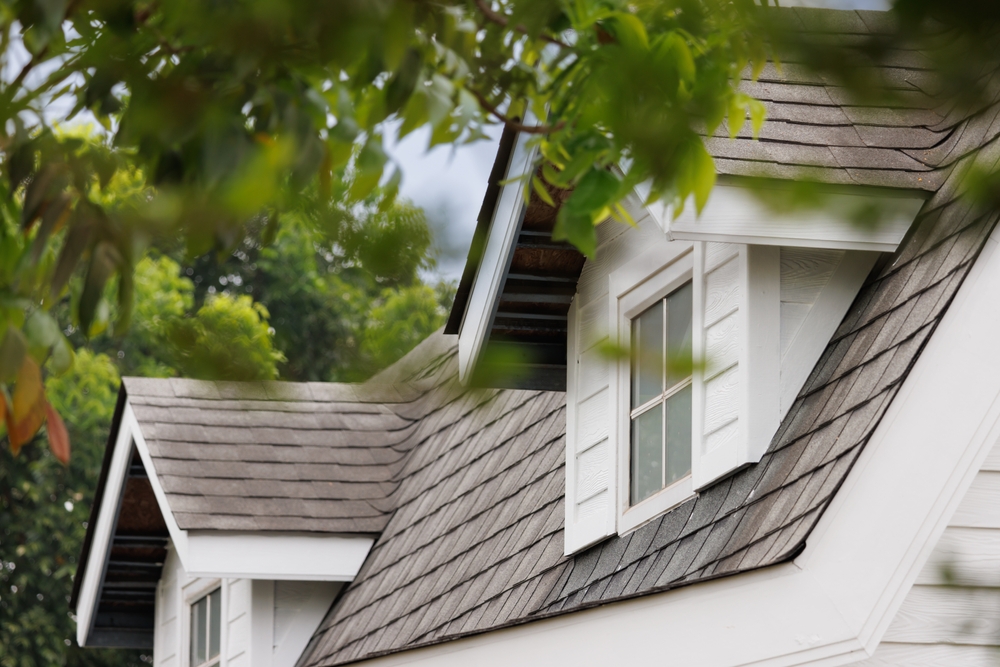
Synthetic shingles are composed of recycled materials, such as plastic and rubber, combined with engineered polymers. They’re designed to mimic the look and feel of cedar shakes or slate tiles, though they’re lighter in weight and easier on the wallet than the real deal.
Thanks to modern manufacturing techniques, synthetic shingles look more realistic than ever before. However, passersby may still be able to discern the difference, especially if your roof is steeply sloped and highly visible.
For this reason, although they work well on any roof, many homeowners prefer to use them on flat or low-pitched surfaces. Not only are they less visible this way, but their waterproof qualities will come in handy during a downpour, as flat roofs don’t usually drain as well.
In addition to repelling water, synthetic shingle materials are also sturdy and long-lasting. Even in high heat and freezing temperatures, they won’t show the same type of wear and tear as natural stone or wood. You don’t have to worry about them warping or fading in the sun or cracking when the temperature drops. They can also withstand impact from hailstones, so they work in even the stormiest regions.
As long as it’s covered with a UV-protective sealant, the only thing you’ll need to do to maintain your synthetic shingle roof is remove overhanging limbs and debris, check your gutters periodically, and promptly replace missing or damaged shingles. If you take care of it well, you can expect this kind of roof to last for 30 to 50 years!
Average cost of synthetic shingles: $7.50 to $15 or more per square foot
Pros:
- Usually less expensive than natural materials
- Made from eco-friendly materials
- Sturdy and durable, even in extreme conditions
- Provides the look of cedar or slate for less
Cons:
- More expensive than traditional asphalt shingles
- Relatively new to the roofing industry and may come with a limited warranty
- Doesn’t look exactly like natural cedar or slate
- Not as easy to source or replace as other common materials
Learn more about synthetic shingles.
Tile Roofing
Common materials used in tile roofing include slate, concrete, and clay tile. Red terracotta is one of the oldest roof materials still in use today and gives any home a warm and sunny visual style. Slate tile roofing has risen in popularity as a premium roofing material with excellent durability and a refined, minimal look.
Slate Tiles
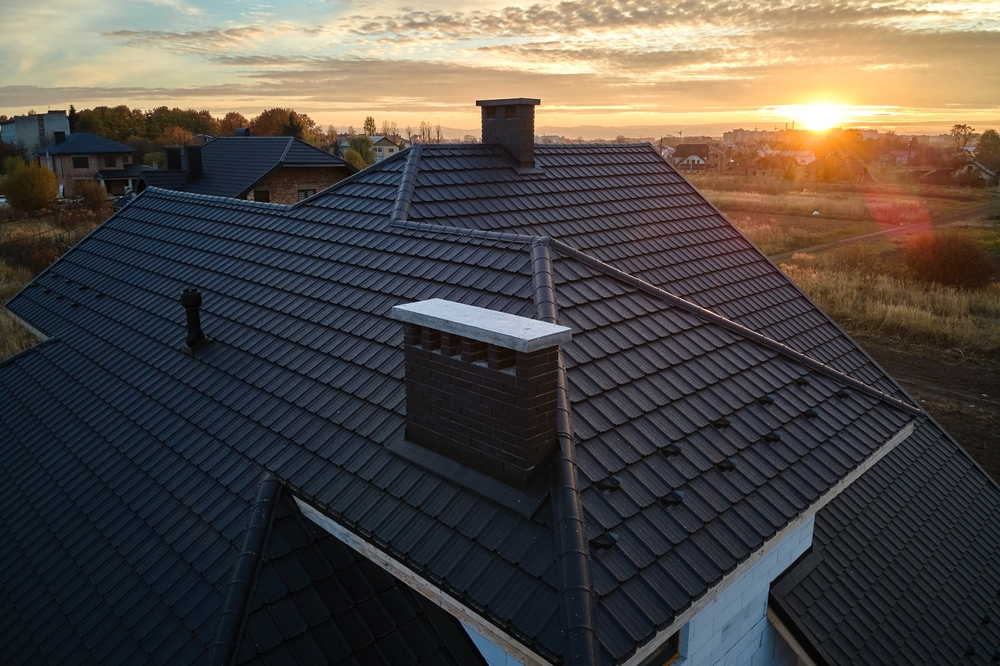
Considered one of the most premium roofing materials, slate shingles are commonly seen on luxury homes. They have a stately appearance that can instantly update the look of your property, though the enhancement can come with a steep price tag. While natural slate is expensive, you can also find synthetic or hybrid models that provide a similar look at a more economical price point.
Though it can be pricey, the upside of a slate roof is that it can last for hundreds of years as long as it’s properly maintained. It also works well in nearly every climate, including regions that are prone to extreme heat and cold. That’s an impressive return on your investment! However, before you start planning, make sure your structure is capable of supporting the weight.
Most slate roofs weigh around 900 to 950 pounds or more per square (equal to 100 square feet), whereas asphalt roofs average around 350 pounds per square. While most homes can support the extra load without modification, a professional roofing company can confirm if yours is a good fit.
Concerning roof type, slate shingles look and operate best on a steep slope. This allows rainwater to naturally flow off the roof, and helps show off their eye-catching beauty!
To keep your slate roof looking its best, focus on preventative maintenance. In addition to scheduling an annual inspection, keep an eye out for cracked or missing tiles, and replace damaged sections promptly.
It’s also important to check your flashings for any leaks that may occur. If you take care of yours, you can expect it to last 50 to 200 years or more!
Average cost of slate shingles: $10 to $30 or more per square foot
Pros:
- Classic, beautiful appearance
- Very durable and long-lasting
- Available in a range of colors and patterns
- Environmentally-friendly roofing option
Cons:
- Can be expensive to install, repair, and replace
- May require retrofitting to ensure your home can hold the weight
- Can crack if mishandled during installation
- May be difficult to source and blend replacement shingles
Learn more about slate tile roofing.
Concrete Tiles
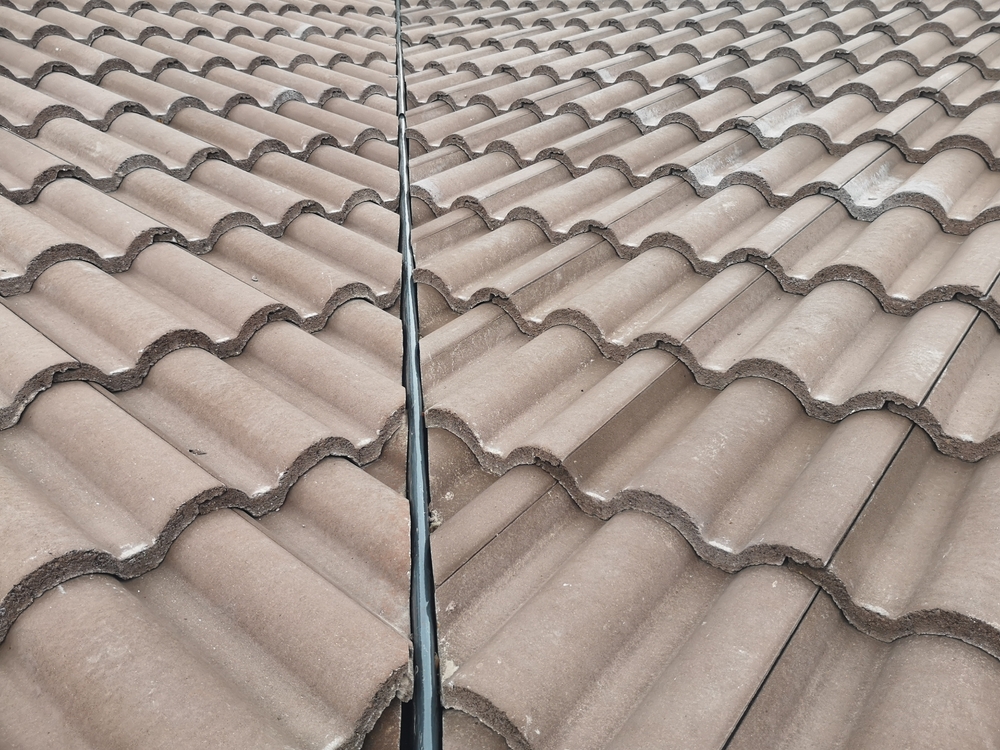
Concrete tiles give a unique appearance to your home or building, offering the look of traditional clay tiles at a more accessible price range. Featuring built-in fire resistance, they’re also hardier and longer-lasting than asphalt alternatives.
Each tile is made from a mixture of cement, sand, water, and iron oxide. Once the mixture is formed, manufacturers can mold and shape it into the desired size. They’re available in a variety of colors, designs, and finishes, including earth tones and pastels, so it’s easy to find a style that fits your preference.
This roofing material comes in three different profiles, including:
- Low/flat
- Medium
- High
Flat tiles, which don’t have any curves, are the most common and can accommodate almost any property style. Medium tiles evoke Mediterranean architecture while higher profiles more closely mimic the look of authentic Spanish tiles. All profiles work well on most rooflines, including steep slopes, but more upkeep is required for flat roofs, as they could be susceptible to water damage.
Concrete tiles are suitable for both warm and cold climates, though they can crack under extreme pressure. If your area sees harsh winters with heavy winds and snow, consult your contractor to choose a type that’s specially designed to support freeze/thaw cycles.
To extend the life of your concrete tile roof, schedule regular inspections and professional cleanings. Most tiles can tolerate gentle pressure washing, which helps remove surface-level grime and debris. If any tiles crack or become damaged, replace them immediately.
You can expect this type of roof to last up to 50 years with proper maintenance, though you may need to replace your underlayment around the 20-year mark.
Average cost of concrete roofing: $9 to $18 per square foot
Pros:
- Sturdy and reliable
- Available in a wide range of colors and styles
- Resistant to fire, pests, and rot
- Less expensive than clay tiles
Cons:
- Heavier than some roofing materials
- More expensive than asphalt tiles
- Can crack and expose underlayment to water
- Installation can be tricky
Learn more about concrete tile roofing.
Clay and Terracotta Tiles
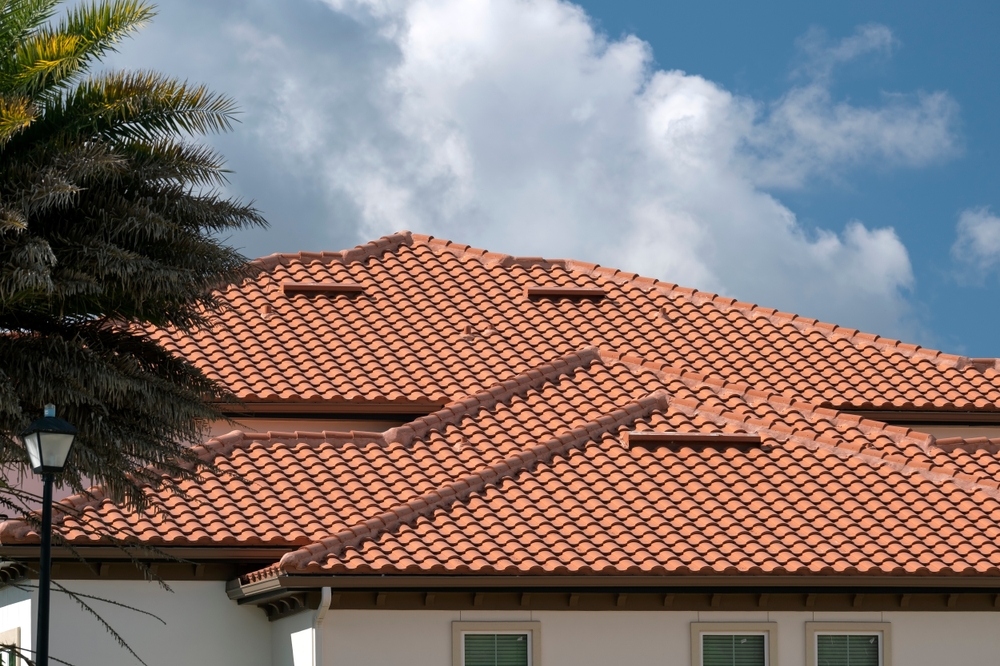
Clay and terracotta tiles are renowned for their Old World beauty. While these two terms are often used interchangeably, it’s the firing process that sets them apart. The tiles begin as natural clay, and then they’re shaped into interlocking or overlapping designs. Once the desired shape is accomplished, the tiles are fired in a kiln, where they transform into terracotta.
These tiles will retain their form and function in nearly every natural event, including wind, fire, snow, and hail. They also boast excellent insulating qualities, UV reflection, and resistance to rot and pests.
While some terracotta tiles can be glazed into ceramic for a special effect, they’re usually kept bare. This is what gives them their characteristic reddish-orange color. Designed to hold up well against high temperatures and salty air, these roofs are especially popular in coastal and desert regions.
If you’re considering terracotta tiles for your property, pay close attention to the slope of your roofline. The tiles can shake on very steep inclines, which makes most varieties unsuitable for roofs with a pitch of 4:12 or above.
Maintaining your clay tile roof is as simple as scheduling annual cleanings and inspections, and replacing cracked or broken tiles as soon as you spot them. It’s best to avoid pressure washing your terracotta roof, as the force could loosen the mortar below the tiles and lead to further damage.
While this kind of roof might cost and weigh a little more than other materials, the return on investment is impressive. A well-maintained clay or terracotta roof can last up to 100 years or longer!
Average cost of terracotta tile roofing: $9 to $26 per square foot
Pros:
- Provide a unique and eye-catching appearance
- Can last for more than a century
- Durable and resistant to aging
- Made from eco-friendly materials
Cons:
- Can crack under weight or impact
- Heavier than metal or asphalt roofing and requires structural support
- One of the most expensive roofing materials
- Require a waterproofing membrane
Learn more about clay tile roofing.
Metal Panels & Tiles
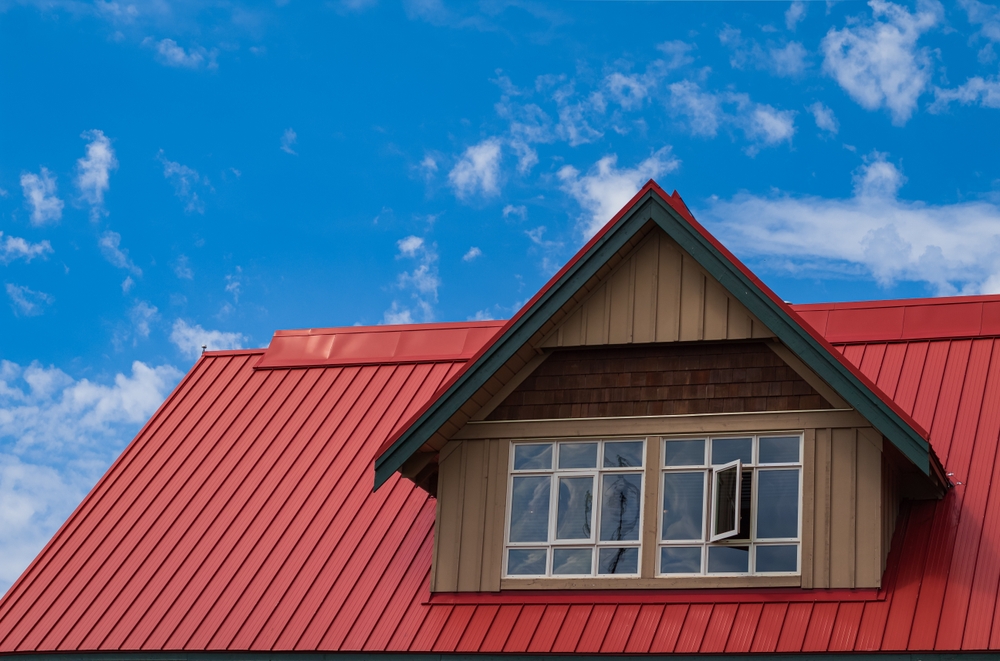
Metal panels, usually made of aluminum, steel, or copper, are one of the most durable types of roofing materials on the market. They’re fireproof, energy-efficient, and strong enough to endure extreme weather conditions.
These panels give a modern, industrial appearance to any structure and come in an array of colors and styles. There are also multiple design options available, including:
- Standing seam metal panels
- Corrugated metal panels
- Ribbed metal panels
Each system can vary greatly in price, appearance, and installation method. All work well on standard or steeply sloped roofs and can accommodate low-sloped roofs at a 3:12 pitch or above. If your roof is flatter, it’s important to consult a roofing company to ensure you’re choosing the right panels. Climate-wise, you can install a metal roof virtually anywhere thanks to its durability, impact resistance, and insulating properties.
Many homeowners prefer standing seam metal roofs for their sleek, seamless appearance. These roofs consist of aluminum or steel panels that interlock at raised seams without exposed fasteners. This makes the panels more resistant to weather fluctuations and keeps maintenance needs low.
Corrugated metal panels are the least expensive to install, featuring lightweight sheets that can be installed on new or existing roofs. Ribbed panels have a special pattern that fortifies their structural integrity and adds strength.
When it’s time to clean your metal roof, the most important step is to remove any loose particles to keep the panels in good condition. A roofing contractor can rinse away any stubborn debris, check the seams, and make any repairs necessary. While a metal roofing system might cost a little more than other materials, your investment can last for 40 to 70 years!
Average cost of metal panel roofing: $4 to $11 per square foot (aluminum); $6 to $16 per square foot (steel); $15 to $30 per square foot (copper).
Pros:
- Durable and long-lasting
- Available in numerous types and colors
- Energy-efficient
- Sustainable and eco-friendly
Cons:
- Can cost more than other options, including asphalt shingles
- Some metals, including copper and aluminum, can dent
- May rust or corrode over time
- Can transfer noise to the interior
Learn more about metal roofing.
Membrane Roofing
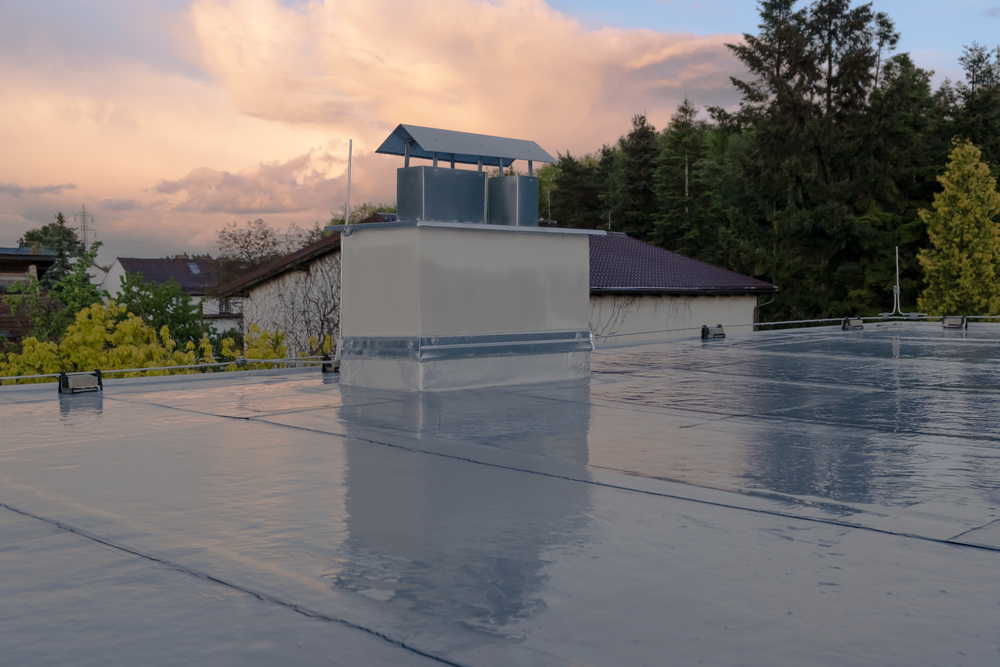
Membrane roofing is another kind of material that works particularly well on low-pitched or fully flat roofs and is especially common on commercial buildings. Flexible or semi-flexible in structure, its chief purpose is to waterproof the surface. When installed, it creates a watertight barrier that protects the interior from drips and leaks.
This type of roofing system can be made from a single material or multiple materials laminated together. Several types of membranes are suitable for this application, including:
- Ethylene propylene diene monomer (EPDM)
- Polyvinyl chloride (PVC)
- Thermoplastic polyolefin (TPO)
- Polychloroprene (neoprene)
- Polymer-modified bitumens
- Chlorinated polyethylene
- Chlorosulfonated polyethylene
Of these options, EPDM roofing, or rubber roofing, is one of the most popular selections. This material is rolled out in large sheets, which means there are fewer seams where water can penetrate.
These roofs work well in all climates, though areas with heavy snowfall will need multiple-layered membranes that can hold up against the chilly temperatures. Single-ply options, including EPDM, PVC, and TPO, can become damaged in such conditions.
To maintain your membrane roofing, promptly remove any debris or grime that accumulates on it. You can also hire a roofing company to wash it with an appropriate roof cleaner. If any scuffs, marks, or holes are visible, they should be able to repair and seal them. Properly kept, a membrane roof can last 25 to 30 years.
Average cost of membrane roofing: $4.25 to $12 per square foot (EPDM); $4 to $10 per square foot (BUR); $5.25 to $13 per square foot (PVC); $4.50 to $14 per square foot (TPO)
Pros:
- Lightweight and flexible
- Excellent waterproofing capabilities
- Proven track record
- Long lifespan
Cons:
- Single-ply options can puncture easily
- Can be challenging to install around accessories (e.g. skylights, air vents)
- Seams can be vulnerable to leaks
- Costs can vary greatly depending on the material used
Learn more about membrane roofing.
Rolled Roofing
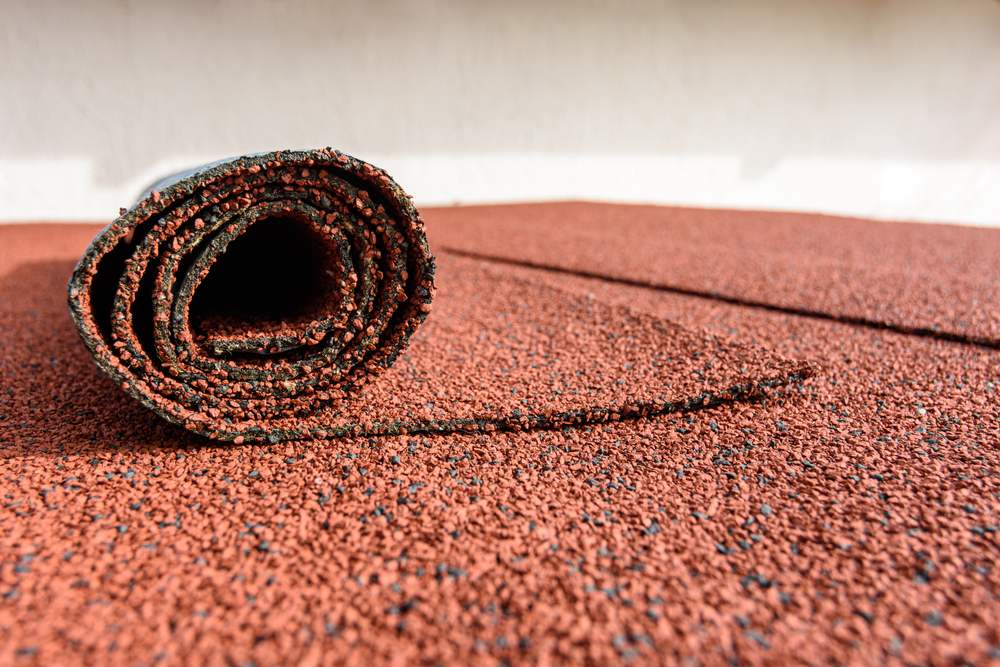
Are you looking for a way to protect and seal your low-slope roof? If so, rolled roofing might be the answer. Each roll covers approximately 100 square feet and measures three feet wide.
This material is very similar to the one used to create asphalt shingles. It consists of a felt or fiberglass mat saturated with asphalt and topped with small mineral granules. Due to its ease of use and affordability, rolled roofing is commonly seen on garden sheds, porches, and temporary structures in addition to residential and commercial properties.
This type of roof works best on flat or low-sloped roofs but isn’t suitable for steeply-sloped properties. That’s because it doesn’t feature the same waterproofing, insulating, UV-blocking, or weather-resisting qualities as some of its counterparts, including asphalt shingles. While it’s versatile and easy to install, rolled roofing works best in mild climates where longevity isn’t the chief concern. Staying up-to-date on all cleanings, inspections, and repairs will keep yours functional for as long as possible, though most rolled roofs only last between 10 and 20 years.
Average cost of rolled roofing: $2 to $5 per square foot
Pros:
- Inexpensive and easily sourceable
- Can be used in a variety of applications
- Quick to install
- Lightweight and easy to transport
Cons:
- Relatively short lifespan
- Limited number of colors and styles
- Not as hard-wearing and durable as other materials
- Limited to flat or low-slope roofs only
Learn more about rolled roofing.
Built-Up Roofing
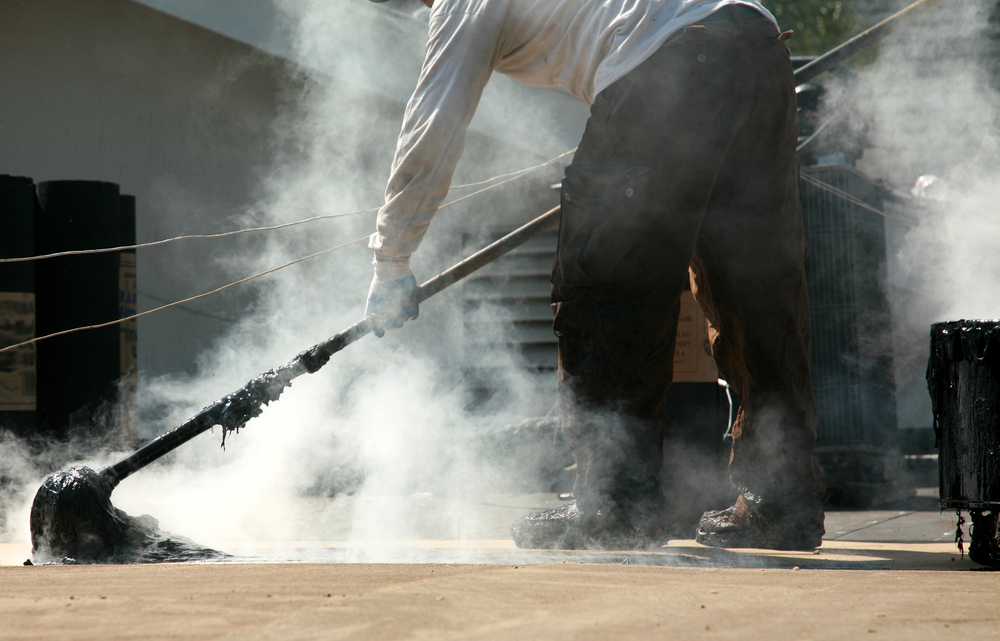
Built-up roofs (BUR) are one of the oldest kinds of roofing systems in the world. First appearing around the mid-1800s, they were an architectural mainstay for decades until single-ply options became available.
These roofs contain alternating layers of asphalt and reinforcing ply sheets (called felts), topped with a cap sheet that consists of small stones or gravel. Best for flat or low-pitched roofs, this material has a high tensile strength and provides superior protection against the elements.
Though most built-up roofs contain the same elements, there are three different installation methods. These include:
- Hot asphalt
- Cold process
- Ballasted
In a hot asphalt installation, the base sheet is mopped with a layer of hot asphalt and then topped with reinforcing felt. These layers repeat two to five times until the roofing system is complete. Cold BUR systems are easier to install and use a standard-temperature adhesive solution that hardens as it cures. Ballasted systems consist of larger pieces of gravel layered on top of a waterproofing membrane.
Effective in most climates and geographical areas, a built-up roof will hold up against most weather events and is also fire-resistant. Most modern systems also feature a reflective layer that offers UV protection.
An annual inspection and preventative repairs should be all you need to keep your roof in good condition. Professional roofers can find and repair common issues, such as separating joints or spots on the surface that look cracked, blistered, or wavy. You can expect your built-up roof to last 20 to 30 years.
Average cost of built-up roofing: $3.50 to $7.50 per square foot
Pros:
- Proven roofing method
- Durable against everyday wear and tear
- Easy to maintain
- Excellent waterproofing capabilities
Cons:
- Heavier than some other roofing materials
- Vulnerable to cracking, splitting, and blistering
- Can emit vapors and fumes during installation
- Not as eco-friendly as other materials
Learn more about built-up roofing.
Solar Panels and Shingles
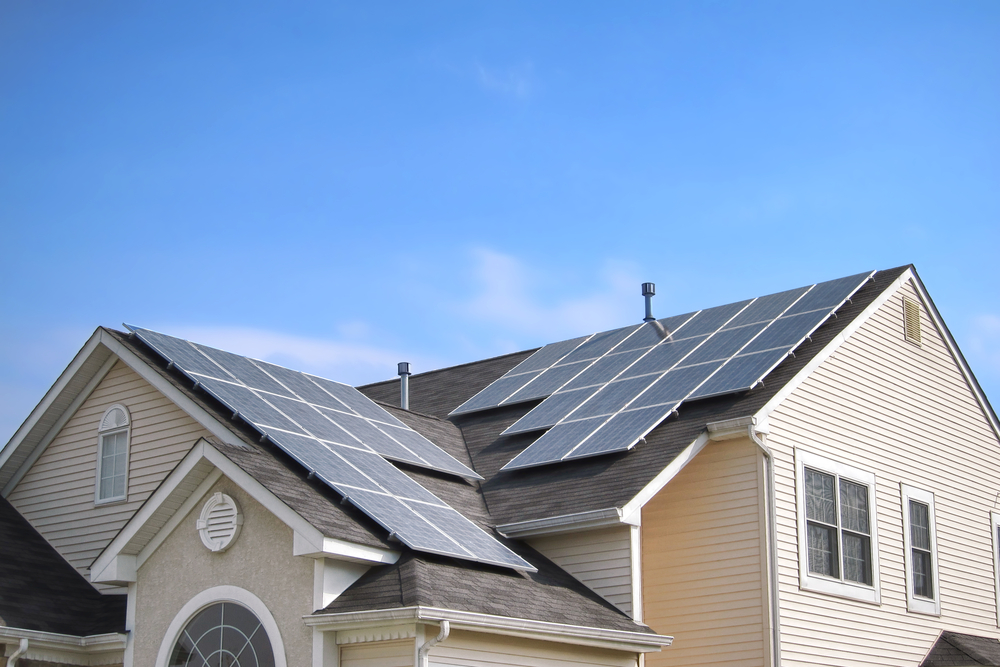
By 2030, experts predict that more than one in seven U.S. homeowners will have solar panels on their roofs. With nationwide solar power capacity exceeding 135,700 megawatts (enough to support 24 million homes), it’s easy to see why this type of roofing system is on the rise.
Solar panels and shingles both capture sunlight and convert it into energy for your home. While panels are more readily available, shingles are quickly becoming more popular due to their slim, low-profile appearance. They consist of photovoltaic (PV) sheets that rest on top of or replace the existing shingles on your roof.
Although solar panels and shingles can be installed on any kind of roofline, they work best when tilted around 15 to 40 degrees. If your roof is completely flat, your roofing company can use special racking equipment, such as brackets or stands, to optimize the angle. It can also be tricky to install panels on a steeply-pitched roof, as there will be shadows to work around.
Before installing rooftop solar panels, pay close attention to the type of roofing system you already have. They work well on top of metal, asphalt, and tile shingles, but aren’t as compatible with clay, slate, or wood. These materials are brittle and can break underfoot during installation.
It’s also helpful to consider your climate. While solar panels need sunlight to function, they don’t require heat. That means even if you live in an area where it’s chilly or snowy most of the year, you could still reap the benefits. However, they won’t be as effective in regions with a substantial amount of regular cloud coverage.
To clean your solar panels, hire professional roofers to wash them with a gentle solution. Scheduling this service twice a year can keep the system working well and looking great. Most solar panel roofs will last 25 to 30 years with proper care.
Average cost of rooftop solar system: $4 to $10 per square foot (panels); $21 to 25 per square foot (shingles)
Pros:
- Energy-efficient option that can lower power bill
- Low-maintenance
- Increasingly affordable as technology improves
- Generates long-term household savings
Cons:
- Can be expensive upfront
- Dependent on sunlight availability
- Not compatible with all roofing materials
- Limited options for disposal or recycling
Learn more about solar panel roofing and shingles.
Green and Living Roofs
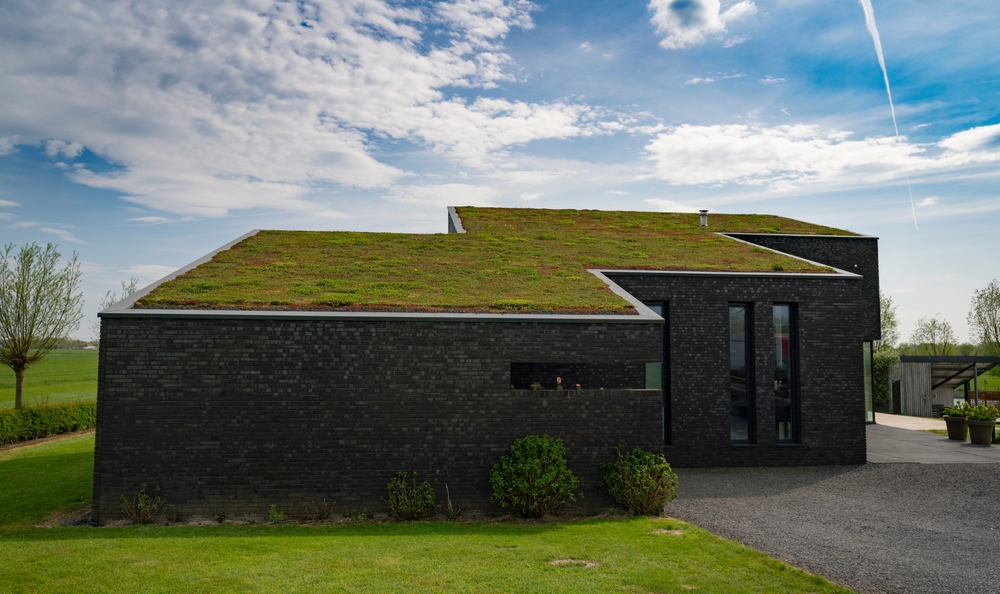
While solar panels are a great way to make your roofing system more eco-conscious, they aren’t the only option. Green roofs, also called living roofs, are another possibility. They consist of a waterproofing membrane topped with soil, moss, and other plants.
While they’ve been popular in Europe for around 40 years, green roofs only started taking hold in the U.S. around a decade ago. Since then, they’ve become more common though they’re still not as well-known as more conventional alternatives. While they can make a striking impression, keep in mind that some local building codes may prohibit them, so check with your building department or zoning board before moving forward.
There are three different types of green roofing systems, characterized by the depth of their plantings, the amount of weight they can sustain, and the level of care required. These include:
- Extensive
- Semi-intensive
- Intensive
Intensive roofs contain around 80 to 150 pounds of vegetation, while extensive roofs usually max out at 25 pounds. Semi-intensive options strike a balance between the two.
Apart from giving you a unique and eye-catching place to grow plants, living roofs also help purify the air, absorb rainwater, and enhance your home’s thermal insulation. When designing one, it’s best to have a slight, gentle slope to your roof to improve drainage and reduce leaking.
One of the best parts of a living roof is you can choose plants that will thrive in your climate zone. As you make your selections, pick varieties that will grow best in your local conditions, taking rainfall, temperature, sunlight, wind, and humidity into account.
Of all the roofing materials listed here, a living roof can be the most labor-intensive to maintain. Following installation, you’ll need to fertilize it and water it for the first few weeks. After that, a contractor should inspect it a few times each year to remove any weeds and add fertilizer periodically. Most green roof membranes last around 30 to 50 years with regular care.
Average cost of living roof: $10 to $30 per square foot
Pros:
- Improves building drainage system
- Protects and extends the lifespan of the roof
- Improves thermal performance
- Provides environmental benefits
Cons:
- Can be costly and time-consuming to maintain
- Not suitable for every roof type
- Not allowed in all building zones
- Heavier than some other materials
Learn more about green and living roofing.
Choose the Best Roofing Materials For Your Needs
With so many roofing materials to choose from, the hardest part is narrowing your selection and choosing the type that will work best for your property, climate, and budget. You also want to select a material that suits the architectural style of your home and accentuates your personal aesthetic.
Then, when it’s time for installation, you want a team you can trust at the helm.
With most roofing systems designed to last for decades or longer, this isn’t a project to take lightly or attempt on your own. You need a professional you can trust to help you navigate the process and ensure quality at every turn.
That’s where we come in.
When you’re ready to start your project, Roofers.com will help you find local roofing companies, compare quotes, and connect with the best team for the job. Get started today!
